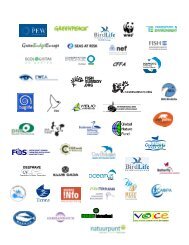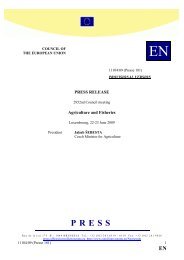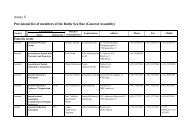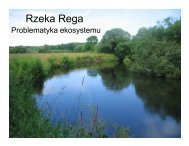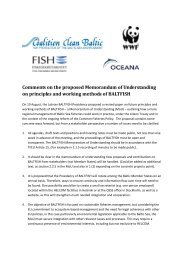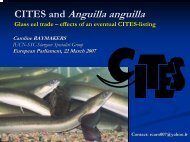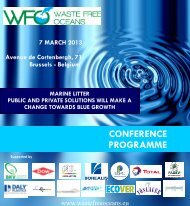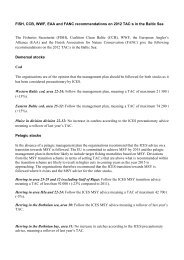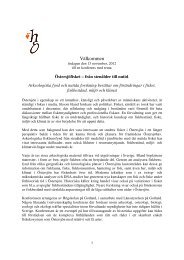A report on iUU fishing of Baltic Sea cod - Fisheries Secretariat
A report on iUU fishing of Baltic Sea cod - Fisheries Secretariat
A report on iUU fishing of Baltic Sea cod - Fisheries Secretariat
You also want an ePaper? Increase the reach of your titles
YUMPU automatically turns print PDFs into web optimized ePapers that Google loves.
the Associati<strong>on</strong> <strong>of</strong> Fish Processors were <str<strong>on</strong>g>report</str<strong>on</strong>g>edas c<strong>on</strong>firming large scale catching and trading inillegal <strong>cod</strong>.The article <str<strong>on</strong>g>report</str<strong>on</strong>g>s that the lack <strong>of</strong> inspecti<strong>on</strong>,the large number <strong>of</strong> licensed fish buyers and thenumerous places where the first sale <strong>of</strong> fish ispossible make it easy for fishermen to land un<str<strong>on</strong>g>report</str<strong>on</strong>g>ed<strong>cod</strong> and for illegal fish to enter the supplychain – as much as 80% <strong>of</strong> the <strong>cod</strong> that goes toprocessors is claimed to be illegal.Comparis<strong>on</strong>s <strong>of</strong> the 2004 Polish <strong>cod</strong> quota andthe export <strong>of</strong> Polish <strong>cod</strong> products were used toshow apparent discrepancies: 16,000 t<strong>on</strong>nes <strong>cod</strong>quota v 52,000 t<strong>on</strong>nes <strong>of</strong> exported <strong>cod</strong> products,which could equate to as much as 70,000–100,000 t<strong>on</strong>nes <strong>of</strong> whole <strong>cod</strong>.Apparently, attempts to establish larger stateowned aucti<strong>on</strong>s have had limited success andare not pr<strong>of</strong>itable as the supply <strong>of</strong> legal fish islimited. The Chairman <strong>of</strong> <strong>on</strong>e <strong>of</strong> these aucti<strong>on</strong>s is<str<strong>on</strong>g>report</str<strong>on</strong>g>ed as saying that EU m<strong>on</strong>ey has been madeavailable to support the building these large aucti<strong>on</strong>sbut they are not pr<strong>of</strong>itable because <strong>of</strong> lowquotas and their inability to trade in illegal fish.While Poland and Sweden were given particularmenti<strong>on</strong>, according to a representative from the<strong>Sea</strong> <strong>Fisheries</strong> Institute in Gdynia, all countriesexceed their nati<strong>on</strong>al <strong>cod</strong> quotas. He also proposesthat a c<strong>on</strong>siderable increase in the quotabut with l<strong>on</strong>ger closed seas<strong>on</strong>s is a soluti<strong>on</strong> tothe problem.The Chairman <strong>of</strong> the Fishermen’s Associati<strong>on</strong>is <str<strong>on</strong>g>report</str<strong>on</strong>g>ed as blaming inadequate quotas as thereas<strong>on</strong> for illegal <strong>fishing</strong>. He says that fishermenknow that there is more fish in the sea. He isalso <str<strong>on</strong>g>report</str<strong>on</strong>g>ed as saying that fishermen <strong>on</strong>ly catchmature fish and highlights that small mesh industrial<strong>fishing</strong> carried out mainly by the Danes andSwedes catches everything.Comment and analysisIf this newspaper article is accurate and theindividuals have not been mis-represented, thenit is a scathing self-analysis and admissi<strong>on</strong> <strong>of</strong> theillegal <strong>fishing</strong> problem in Poland.Comparing exports with the annual nati<strong>on</strong>alquota to provide an estimate <strong>of</strong> un<str<strong>on</strong>g>report</str<strong>on</strong>g>ed<strong>fishing</strong> may be misleading. It does not take intoaccount the significant quantities <strong>of</strong> <strong>cod</strong> that areimported into Poland (see table 3 above).The article seems to suggest that the state-ownedaucti<strong>on</strong>s restrict the sale <strong>of</strong> illegal fish. Whilethe c<strong>on</strong>sequence <strong>of</strong> this may be to compromisetheir ability to compete with other aucti<strong>on</strong>s, itdoes raise the questi<strong>on</strong> as to how they are able toachieve this.Pers<strong>on</strong>al perspectives and opini<strong>on</strong>s <strong>on</strong> IUU<strong>fishing</strong> for <strong>cod</strong> in the <strong>Baltic</strong> <strong>Sea</strong>A series <strong>of</strong> informal meetings with individualswith an active interest in <strong>Baltic</strong> <strong>Sea</strong> fisheriestook place throughout the course <strong>of</strong> the project.Fishermen/fishermen’s representatives, fish processors,fisheries inspectors and fisheries scientistswere targeted as they were c<strong>on</strong>sidered likely toknow most about the IUU <strong>fishing</strong> problem. Anumber <strong>of</strong> individuals within envir<strong>on</strong>mental n<strong>on</strong>governmentalorganisati<strong>on</strong>s (ENGOs) with eitherexperience <strong>of</strong> working with IUU and/or <strong>Baltic</strong><strong>Sea</strong> fisheries issues were also c<strong>on</strong>tacted, as were anumber <strong>of</strong> academics that had previously c<strong>on</strong>ductedresearch <strong>on</strong> <strong>Baltic</strong> <strong>Sea</strong> fisheries. Latterly, ameeting was held with investigative TV journalistswho had undertaken work <strong>on</strong> IUU <strong>fishing</strong> inthe <strong>Baltic</strong> <strong>Sea</strong> and, more recently, the Barents <strong>Sea</strong>.MethodologyIn preparati<strong>on</strong> for these interviews, the literatureand Internet search described above enabled apr<strong>of</strong>ile <strong>of</strong> each <strong>of</strong> the EU Member States’ andthe Russian Federati<strong>on</strong>’s <strong>fishing</strong> industries tobe drafted and provided an important source<strong>of</strong> background informati<strong>on</strong>. These pr<strong>of</strong>iles arepresented in Annex I.A list <strong>of</strong> general and more specific questi<strong>on</strong>s, thelatter being tailored to particular target groups,was prepared and formed the basis <strong>of</strong> an informalinterview. Depending <strong>on</strong> the answers to thesequesti<strong>on</strong>s, supplementary questi<strong>on</strong>s were asked.It should noted that the questi<strong>on</strong>s were not part<strong>of</strong> any analytical framework that allowed forobjective analysis and c<strong>on</strong>clusi<strong>on</strong>s to be drawn;rather, it was purely a subjective process but <strong>on</strong>ethat was c<strong>on</strong>sidered to provide better understanding<strong>of</strong> the IUU <strong>fishing</strong> problem.Face-to-face interviews, ph<strong>on</strong>e interviews andwritten resp<strong>on</strong>ses through email corresp<strong>on</strong>dence– 14 –



